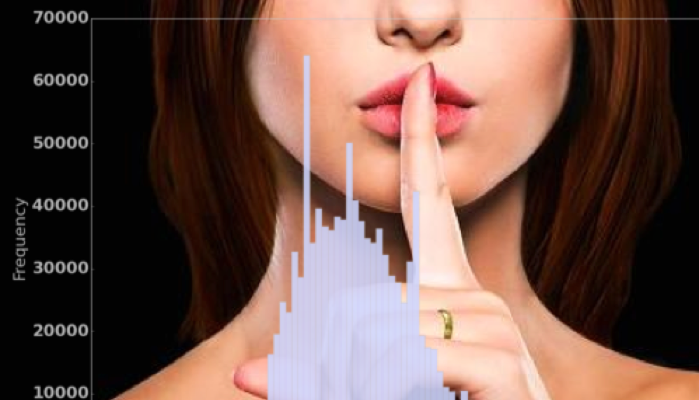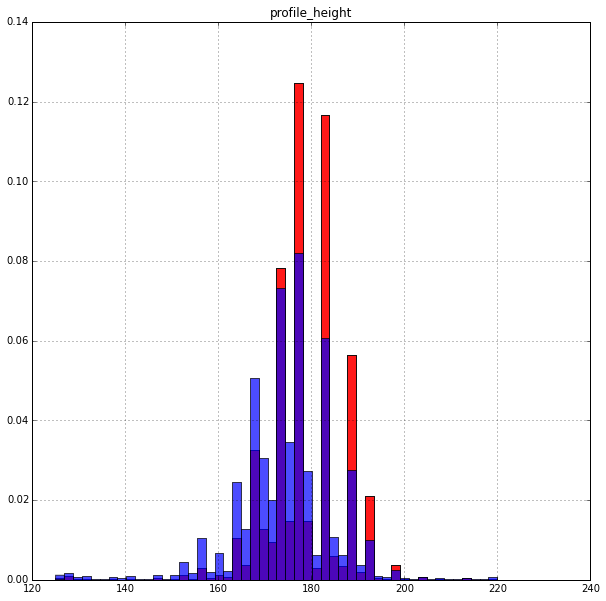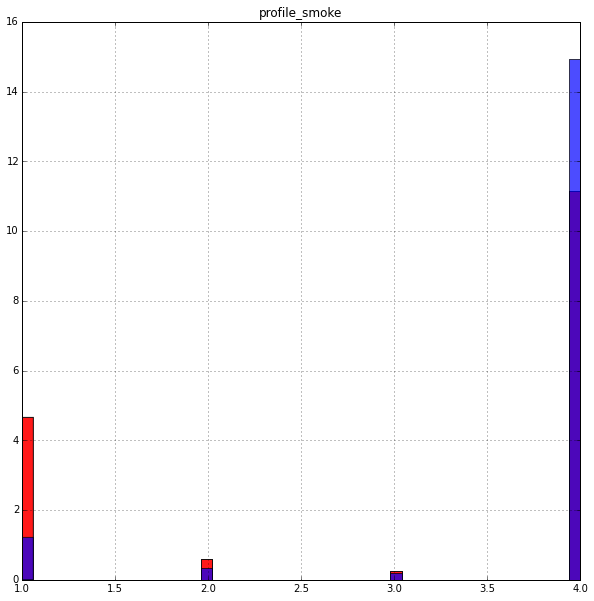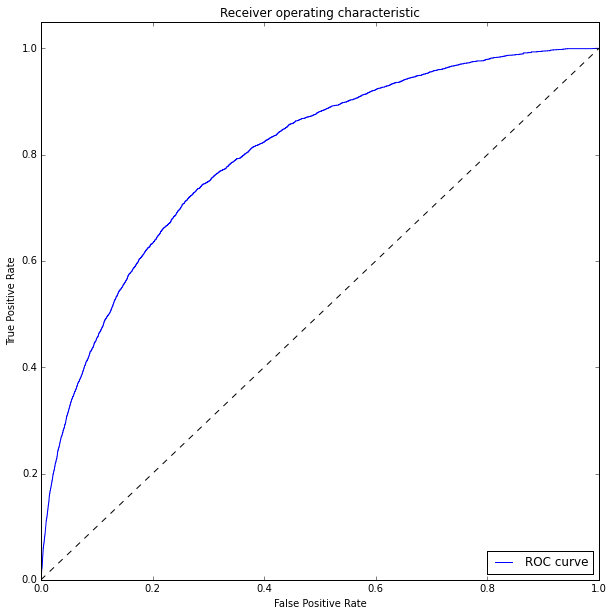Why do I need AshleyMadison if I do not smoke?
As you all probably already know, dumps of AshleyMadison bases have recently been posted. I decided not to miss the opportunity and analyze the real data of the dating platform. Let’s try to predict the solvency of the client by its characteristics such as age, height, weight, habits, etc.

Will we try?
In this example, I will use iPython notebook. For those who are engaged in data analysis in Python and have not yet used iPython notebook - I highly recommend it!
To build the model we will use anonymized data.
1. Preparing data in MySQL
First, fill in the dumps in MySQL and delete all users with id <35,000,000 for ease of further processing. I took the member_details and aminno_member tables.
Data filling is not very fast, even on a server with SSD (some tables weigh about 10 Gigabytes)
Next, we need to fill in the payment data from csv and get the amount for each user. The result was a pays table with id and sum fields.
2. Load the data into pandas
Joynim 3 tables by user id and get a DataFrame for further processing. We take only users with photos, I think that this is a sign of at least some activity in the system:
We extract the year and month of birth:
Let's try to analyze whether the target variable (paid / not paid) depends on the characteristics of the user? Does it make sense to build a model?
We divide the analyzed users into 2 parts: df0 - those who paid at least some, df1 - did not pay anything.
We build 2 histograms for each of the user parameters. Red ones - those who paid, blue ones - who did not pay.
Consider the most interesting:
Year of birth:

The result is quite expected: age affects the target variable. Seniors pay more willingly. The peak of the histogram for paying is around 35 years old.
Weight:

It’s more interesting: those who weigh more are more likely to pay. Although also quite logical
Growth:

High pay a little more willingly. The distribution is very uneven. Perhaps the growth on the site is set not by a number, but by a gap.
Smoking:

To the question of the title of the article. There is a clear dependence, the question is - what do the values of 1,2,3,4 mean?
The remaining user parameters do not give such an interesting picture, although they also have their own contribution. Here is the full version of this notebook where you can see all the histograms.
2. Prediction of the probability of payment.
First, we select the target variable (paid / not paid) which we will predict:
Select categorical signs and binarize them:
Select metric features and combine them with the result of binarization:
We break the sample into 2 parts 90% and 10%. At the first we will train and tune the model. The second is to evaluate the accuracy of the resulting model.
We train the RandomForest classifier and select the optimal parameters.
Assess the significance of the signs:
The most significant (by decreasing significance): year_of_birth, profile_weight, profile_height.
We evaluate the quality of the model on the test sample and construct the ROC curve:

To measure the quality of the classifier, we will use ROC_AUC score
ROC_AUC = 0.79926
Results It is
really possible to predict the tendency of users to pay for services. The accuracy is not very high (roc_auc = 0.8), but we used only part of the parameters and generally did not pay attention to behavioral factors (no data).
What's next?
UPD:
For those who want to play around with the data, I spread the DataFrame dump on their own
yadi.sk/d/YaNM8DTZj2ybn
And go ahead!

Will we try?
In this example, I will use iPython notebook. For those who are engaged in data analysis in Python and have not yet used iPython notebook - I highly recommend it!
To build the model we will use anonymized data.
1. Preparing data in MySQL
First, fill in the dumps in MySQL and delete all users with id <35,000,000 for ease of further processing. I took the member_details and aminno_member tables.
Data filling is not very fast, even on a server with SSD (some tables weigh about 10 Gigabytes)
Next, we need to fill in the payment data from csv and get the amount for each user. The result was a pays table with id and sum fields.
2. Load the data into pandas
Joynim 3 tables by user id and get a DataFrame for further processing. We take only users with photos, I think that this is a sign of at least some activity in the system:
engine = create_engine('mysql://login:pass@localhost:3306/db') # Creating MySQL engine
sql = """
SELECT md.pnum, p.sum, am.gender, am.photos_public, md.profile_weight, md.profile_height,
md.eye_color, md.hair_color, md.dob,
md.profile_smoke, md.profile_ethnicity,
md.profile_bodytype, md.profile_initially_seeking
FROM `member_details` AS md
JOIN `aminno_member` AS am
ON md.pnum = am.pnum
LEFT JOIN pays AS p
ON md.pnum = p.id
WHERE md.dob is not null
AND (am.photos_public > 0 OR p.sum is not NULL)
"""
df = pd.read_sql_query(sql, engine).fillna(0).set_index('pnum') #Reading data from mysql DB to pandas dataframe
We extract the year and month of birth:
df['month_of_birth'] = df['dob'].apply(lambda x:x.month)
df['year_of_birth'] = df['dob'].apply(lambda x:x.year)
Let's try to analyze whether the target variable (paid / not paid) depends on the characteristics of the user? Does it make sense to build a model?
We divide the analyzed users into 2 parts: df0 - those who paid at least some, df1 - did not pay anything.
THRESHOLD = 0.0001
df0 = df[(df['sum'] > THRESHOLD)]
df1 = df[(df['sum'] < THRESHOLD)]
We build 2 histograms for each of the user parameters. Red ones - those who paid, blue ones - who did not pay.
cols = ['profile_weight','profile_height','year_of_birth','month_of_birth',
'eye_color', 'hair_color','profile_smoke', 'profile_ethnicity',
'profile_bodytype', 'profile_initially_seeking','gender']
for col in cols:
plt.figure(figsize=(10,10))
df0[col].hist(bins=50, alpha=0.9, color = 'red', normed=1)
df1[col].hist(bins=50, alpha=0.7, normed=1)
plt.title(col)
plt.show()
Consider the most interesting:
Year of birth:

The result is quite expected: age affects the target variable. Seniors pay more willingly. The peak of the histogram for paying is around 35 years old.
Weight:

It’s more interesting: those who weigh more are more likely to pay. Although also quite logical
Growth:

High pay a little more willingly. The distribution is very uneven. Perhaps the growth on the site is set not by a number, but by a gap.
Smoking:

To the question of the title of the article. There is a clear dependence, the question is - what do the values of 1,2,3,4 mean?
The remaining user parameters do not give such an interesting picture, although they also have their own contribution. Here is the full version of this notebook where you can see all the histograms.
2. Prediction of the probability of payment.
First, we select the target variable (paid / not paid) which we will predict:
y = (df['sum'] > THRESHOLD).astype(np.int32)
Select categorical signs and binarize them:
categorical = ['month_of_birth',
'eye_color', 'hair_color','profile_smoke', 'profile_ethnicity',
'profile_bodytype', 'profile_initially_seeking']
ohe = preprocessing.OneHotEncoder(dtype=np.float32)
Xcategories = ohe.fit_transform(df[categorical]).todense()
Select metric features and combine them with the result of binarization:
numeric = ['gender','profile_weight','profile_height','year_of_birth']
Xnumeric = df[numeric].as_matrix()
X = np.hstack((Xcategories,Xnumeric))
We break the sample into 2 parts 90% and 10%. At the first we will train and tune the model. The second is to evaluate the accuracy of the resulting model.
X_train, X_test, y_train, y_test = cross_validation.train_test_split(X, y, test_size=0.1, random_state=7)
We train the RandomForest classifier and select the optimal parameters.
from sklearn.preprocessing import StandardScaler
from sklearn.ensemble import RandomForestClassifier
from sklearn import decomposition, pipeline, metrics, grid_search
rf = RandomForestClassifier(random_state=7, n_jobs=4)
scl = StandardScaler()
clf = pipeline.Pipeline([('scl', scl),
('rf', rf)])
param_grid = {'rf__n_estimators': (100,200),
'rf__max_depth': (10,20),
}
model = grid_search.GridSearchCV(estimator = clf, param_grid=param_grid, scoring='roc_auc',
verbose=10, cv=3)
model.fit(X_train, y_train)
print("Best score: %0.3f" % model.best_score_)
print("Best parameters set:")
best_parameters = model.best_estimator_.get_params()
for param_name in sorted(param_grid.keys()):
print("\t%s: %r" % (param_name, best_parameters[param_name]))
Best score: 0.802
Best parameters set:
rf__max_depth: 20
rf__n_estimators: 200
Assess the significance of the signs:
best = model.best_estimator_
print best.steps[1][1].feature_importances_
[ 0.01083346 0.00745737 0.00754652 0.00764087 0.0075468 0.00769951
0.00780227 0.0076059 0.00747405 0.00733789 0.00720822 0.00720196
0.01067164 0.00229657 0.00271315 0.00403617 0.00453246 0.00420906
0.01227852 0.00166965 0.00060406 0.00293115 0.00347255 0.00581456
0.00176878 0.00060611 0.00129565 0.06303697 0.00526695 0.00408359
0.04618295 0.03014204 0.00401634 0.00312768 0.0041792 0.00073294
0.00260749 0.00137382 0.00385419 0.03020433 0.00788376 0.01423438
0.00953692 0.01218361 0.00685376 0.00812187 0.00433835 0.00294894
0.01210143 0.00806778 0.00458055 0.01323813 0.01434638 0.0120177
0.03383968 0.1623351 0.11347244 0.2088358 ]
The most significant (by decreasing significance): year_of_birth, profile_weight, profile_height.
We evaluate the quality of the model on the test sample and construct the ROC curve:
from sklearn.metrics import roc_curve,roc_auc_score
y_pred = best.predict_proba(X_test).T[1]
print roc_auc_score(y_test, y_pred)
fpr, tpr , thresholds = roc_curve(y_test, y_pred)
plt.figure(figsize=(10,10))
plt.plot(fpr, tpr, label='ROC curve')
plt.plot([0, 1], [0, 1], 'k--')
plt.xlim([0.0, 1.0])
plt.ylim([0.0, 1.05])
plt.xlabel('False Positive Rate')
plt.ylabel('True Positive Rate')
plt.title('Receiver operating characteristic')
plt.legend(loc="lower right")
plt.show()

To measure the quality of the classifier, we will use ROC_AUC score
ROC_AUC = 0.79926
Results It is
really possible to predict the tendency of users to pay for services. The accuracy is not very high (roc_auc = 0.8), but we used only part of the parameters and generally did not pay attention to behavioral factors (no data).
What's next?
- You can try to predict something based on tastes / preferences. In the database there are fields 'pref_opento', 'pref_lookingfor' of the form “12 | 17 | 58 | 97” - these are links to some kind of reference book which does not exist. You can build a model without it, but you cannot interpret it.
- Try a regression model and predict the amount, not the fact of payment.
- Play around with algorithms, sample size, sample parameters (I used photos_public> 0)
- Your suggestions?
UPD:
For those who want to play around with the data, I spread the DataFrame dump on their own
yadi.sk/d/YaNM8DTZj2ybn
import joblib
import pandas as pd
df = joblib.load("1.pkl")
print df
And go ahead!
